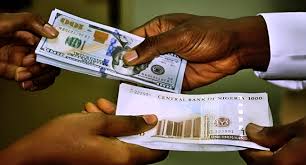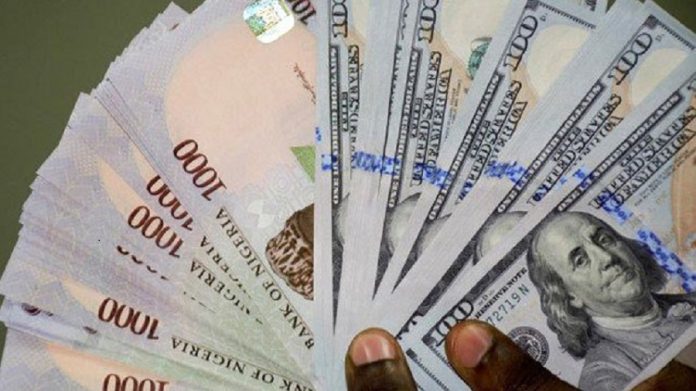The naira has maintained relative stability in the foreign exchange (FX) market as the Central Bank of Nigeria (CBN) dollar inflow fluctuates in the market.
Nigeria’s gross external reserves declined by eight per cent year-to-date to $37.84 billion as of April 28, 202,5, from $40.88 billion at the beginning of the year, according to data from the Central Bank of Nigeria (CBN).
The naira has recorded appreciation since January, after the introduction of the Electronic Foreign Exchange Matching System (EFEMS) and the foreign exchange codes by the CBN.
At the Nigerian Foreign Exchange Market (NFEM), the naira has gained 3.8 per cent of its value against the dollar in the last four months, closing at N1,599.70 on Tuesday compared to N1,661.12 on December 2, 2024, when transactions commenced on EFEMS.
The naira also appreciated in the parallel market, also known as the black market, gaining 3.2 per cent or N52 year-to-date, as the dollar was quoted at N1,608 on Tuesday compared to N1,660 in January 2025.
The NAFEM window recorded an inflow of $735mn compared to $1.42bn in the previous week, a report by Coronation Merchant Bank Limited said.
The CBN accounted for 33.47 per cent of the total inflows, while foreign portfolio investors (FPIs) were responsible for 11.99 per cent. Non-bank corporates brought in 31.76 per cent; exporters accounted for 21.17 per cent, while other sources attracted 1.61 per cent.
According to the Coronation report, the Naira gained 0.02 per cent week/week against the US Dollar in the official spot market, closing at N1,599.55/US$1.
The 1-month forward rate closed at N1,650.54/$1. The three-month forward contract rate closed at N1,730.03/$1. The 6-month forward contract closed at N1,846.90/US$1. The 1-year forward rate closed at N2,074.22/US$1.
At the parallel market, the naira gained 0.31 per cent against the dollar, closing at N1,599.55/US$1 on Friday (25th April 25).
After the Easter celebration, the CBN recorded the highest dollar sale in one week, accounting for 50 per cent of inflows.
Last Tuesday, after trading at the NFEM, the naira depreciated slightly by 0.2 per cent as the dollar was quoted at N1,602.63 compared to N1,599.93 seen on Thursday last week before the Easter holiday, data from the CBN showed.
The naira also closed flat, steadying at N1,610 per dollar in the parallel market, also known as the black market, according to data collated from street traders and online platforms.
The NAFEM window recorded an inflow of $1.42 billion compared to $847 million from the previous week, a report by Coronation Merchant Bank Research. The CBN accounted for 50.60 per cent of the total inflow. Foreign Portfolio Investors (FPIs) earned 8.61 per cent; non-bank corporates brought in 25.14 per cent; exporters, 12.99 per cent; while other sources accounted for 2.66 per cent.
According to data from CBN, the gross foreign reserves decreased by 0.39 per cent w/w to close at $37.88 billion as of April 16, 2025. Turning to the Chinese Yuan, the naira lost 0.44 per cent against the Chinese Yuan (CNY), to close at N219.16CNY/N.
Net foreign exchange inflows into the Nigerian economy declined to $4.79 billion in January 2025, down from $5.01 billion recorded in December 2024, representing a 4.4 per cent drop, according to the latest data released by the CBN.
The CBN attributed this decline to reduced inflows through its own channels, even as total foreign exchange inflows into the economy also dipped.
Total foreign exchange inflows for January stood at $9.63 billion, a decrease from the $10.17 billion reported in December. Correspondingly, outflows fell to $4.84 billion in January from $5.17 billion the previous month. The lower figures on both sides reflect a slowing activity in the foreign exchange space, especially in transactions routed through the apex bank.
The CBN’s economic report for January highlighted that inflows through the CBN declined significantly to $2.33 billion, compared with $4.09 billion in December. Meanwhile, autonomous inflows rose to $7.31 billion from $6.08 billion in the preceding month, indicating increased activity by FX market players and non-CBN sources.
On the outflow side, funds exiting through the CBN also declined to $3.80 billion from $4.16 billion, while autonomous outflows slightly increased to $1.04 billion from $1.01 billion recorded in December.
The movement in flows led to a net outflow of $1.47 billion through the CBN in January, a stark contrast to the marginal net outflow of $0.07 billion in December. On the other hand, net inflows from autonomous sources improved to $6.26 billion in January, up from $5.07 billion a month earlier, reinforcing the increasing role of private sources in the FX ecosystem.






